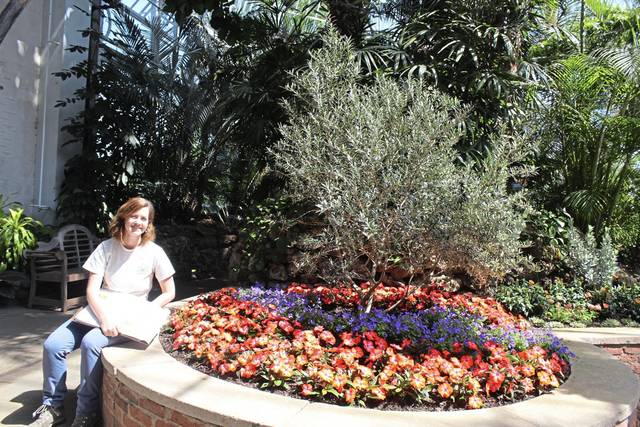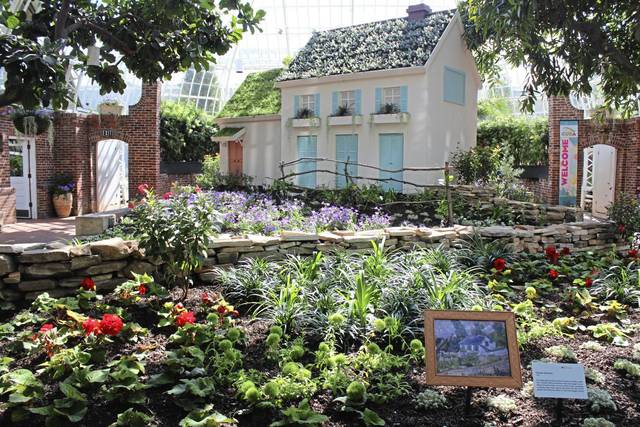'Van Gogh in Bloom' is summer show at Phipps Conservatory
Artist Vincent Van Gogh (1853-1890) once said, “If you truly love nature, you will find beauty everywhere.”
The Dutch post-impressionist painter’s own love of nature expressed in his vibrant landscapes and still-life paintings is interpreted in a series of botanical vignettes in the summer flower show, “Van Gogh in Bloom,” at Phipps Conservatory and Botanical Gardens.
The show opens May 11 and runs through Oct. 6 at the historic Oakland glass house.
Jordyn Melino, associate director of exhibits at Phipps, designed the show that incorporates dried plant materials and 130 different types of plants, many grown from seed and flower plugs, into representations of several of Van Gogh’s paintings.
Vibrant palate
A print of the featured paintings in each of the rooms gives visitors an opportunity to compare the artwork with Melino’s recreation of the work that incorporates an overall palate heavy on vibrant colors such as reds, oranges and yellows – one of the Dutch artist’s trademarks.
“He never used the color pink in any of his works,” the designer said, “but always used bright shades.”
Coming off the spring flower show, with its pastel varieties of tulips, hyacinths and other seasonal blooms, Melino was challenged to work outside her comfort zone when it came to choosing brilliant flowers for this show.
Creative interpretations
She especially shows her creativity in the Victoria Room, with her interpretation of Van Gogh’s “Starry Night over the Rhone” (1888), one of three paintings the artist created representing a nighttime scene. Her use of Craspedia globosa ‘Sun Ball’ flowers in window boxes depicts stars accented by “Serena Blue” snapdragon and “Dark Star” coleus.
The “Sun Ball” flowers are generating the most questions from visitors, she said, for their whimsical brilliant golden-yellow, one-inch-round blooms at the top of long stems. Melino says they make perfect cut flowers for arrangements and can also be dried.
In the Broderie Room, she used groupings of orange and yellow dahlias, zinnias, Gerber daisies and coral bells to illustrate Van Gogh’s “Sunflowers” – since actual sunflowers aren’t blooming until late summer. She joked that since the room is a popular setting for wedding ceremonies, it could be a problem if a proliferation of sunflower seeds might attract some unwelcome birds to sneak in.
The Sunken Garden depicts Van Gogh’s 1988 work, “The Night Café,” a snapshot of the Café de l’Alcazar he visited in the south of France. A few empty wine and liquor bottles and two pool tables with planted dried materials in “a clash and contrast of the most disparate reds and greens” illustrate the “terrible passions of humanity” that the artist described to his brother in a letter. Melino used double red tropical hibiscus, ‘Daystar Yellow’ trailing hybrid begonia, ‘Estrella Voodoo Red’ verbena and other plants to help set the mood.
The Palm Court is a representation of Van Gogh’s painting, “Olive Trees with Yellow Sky and Sun” (1889), one of 15 canvases of olive trees he created in seven months while in the asylum of St-Paul in St-Remy, France, where he is said to have created his most profound works.
Olive trees are native to Europe and not the U.S., but the conservatory was able to source some from growers, providing an authentic touch to the display.
The designer said her favorite part of the show — which includes nine interpretations of Van Gogh paintings — is in Phipps’ Welcome Center, where the artist’s “Self Portrait with Straw Hat” (1887) is recreated in ‘Black Scallop’ and ‘Burgundy Glow’ bugleweed and ‘Orange’ and ‘Yellow’ florist kalanchoe.
Visitors are drawn to the likeness upon entering the show, she said, “and it still blows me away.”
Growing with Van Gogh classes
Phipps has incorporated a series of “Growing with Van Gogh” classes into its adult education program during the “Van Gogh in Bloom” exhibit. The classes are designed to provide a new perspective on the famous artist, as well as ways to bring his iconic style into homes and gardens. Registration information is on Phipps’ website.
Candy Williams is a Tribune-Review contributing writer.
Remove the ads from your TribLIVE reading experience but still support the journalists who create the content with TribLIVE Ad-Free.






